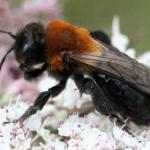Andrena melanocephala KIRBY, 1802
A large and distinctive species with bright foxy-red hairs on the thorax and a polished black abdomen.
This species is locally common in coastal localities in southern Britain, but is also known from a number of inland sites, often on heathy soils, where it rarely attains the abundance of some of its coastal locations. Males patrol nesting areas, flying extremely quickly along the edge of cliffs, just below the top edge. It is widespread, but rarely common, in Europe. It is also found throughout the steppe regions of Asia.
This species is not regarded as being scarce or threatened.
May be found in open, sandy-grassland habitats, particularly where these are associated with exposed vertical cliffs, which provide the favoured nesting sites.
Bivoltine: March to May and July to August
Strongly associated with vertical cliffs of sandy material, but may also use more level sandy areas.
There are no strong preferences in the flowers visited, these include members of the Brassicaceae, Asteraceae, Lamiaceae, Onagraceae and Salicaceae.
The cuckoo-bee Nomada goodeniana (Perkins, 1919) and N. fulvicornis (Westrich, 1989) parasitise this species.
2006


